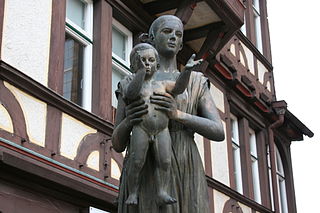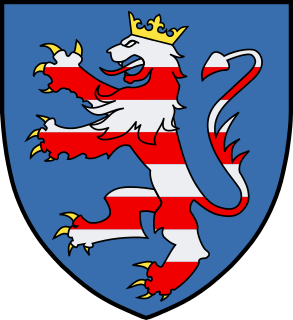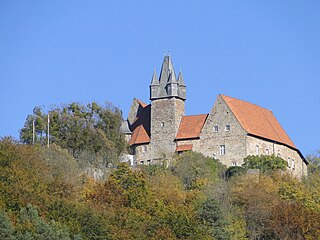
Henry I of Hesse "the Child" was the first Landgrave of Hesse. He was the son of Henry II, Duke of Brabant and Sophie of Thuringia.

The House of Hohenlohe is a German princely dynasty. It ruled an immediate territory within the Holy Roman Empire which was divided between several branches. The Hohenlohes became imperial counts in 1450. The county was divided numerous times and split into several principalities in the 18th century.

Neuenstein is a community in Hersfeld-Rotenburg district in northeastern Hesse, Germany.

Louis I of Hesse, called "the Peaceful", was Landgrave of Lower Hesse (Hesse) from 1413 to 1458.

The Ludovingians or Ludowingians were the ruling dynasty of Thuringia and Hesse during the 11th to 13th centuries.

Johann Reinhard III of Hanau-Lichtenberg was the last of the counts of Hanau-Lichtenberg. He reigned from 1680 to 1736. From 1712 to 1736, he also reigned the County of Hanau-Münzenberg.
The Duchy of Thuringia was an eastern frontier march of the Merovingian kingdom of Austrasia, established about 631 by King Dagobert I after his troops had been defeated by the forces of the Slavic confederation of Samo at the Battle of Wogastisburg. It was recreated in the Carolingian Empire and its dukes were appointed by the king until it was absorbed by the Saxon dukes in 908. From about 1111/12 the territory was ruled by the Landgraves of Thuringia as Princes of the Holy Roman Empire.
William I "the Elder" of Hesse-Rotenburg was from 1683 until his death Landgrave of Hesse-Rotenburg. He was a son of Ernest I of Hesse-Rotenburg-Rheinfels and his wife, Countess Maria Eleonore of Solms-Lich. William was nicknamed the Elder to distinguish him from his nephew, William of Hesse-Wanfried.
Henry VII of Waldeck was Count of Waldeck from 1397 until his death, after which he acted several times as bailiff for the Electorate of Mainz in Upper and Lower Hesse.

Landgrave Frederick of Hesse-Eschwege was from 1632 until his death Landgrave of the apanage of Hesse-Eschwege, which stood under the suzerainty of Hesse-Kassel.
Ulrich II, Lord of Hanau was Lord of Hanau from 1305/1306 until his death.
Otto III, Count of Waldeck-Landau was the second ruling count of the elder Waldeck-Landau line, which had started. He was the son of Count Adolph III, who had founded the elder Waldeck-Landau in 1397, and his wife, Agnes of Ziegenhain.
Elisabeth of Hanau was a daughter of Lord Ulrich V and his wife, Countess Elisabeth of Ziegenhain. She died on 25 May 1475 and was buried in the Gnadental monastery in Michelfeld.
John, Count of Nassau-Dillenburg was the third son of Count Otto I of Nassau and his wife Agnes, daughter of Count Emich IV of Leiningen-Landeck. John was a first cousin of King Adolf of the Romans.
Gottfried VIII, Count of Ziegenhain was a German nobleman. He was the ruling Count of Ziegenhain and Nidda from 1372 until his death. He is best known as the leader of the Star League, an alliance of local nobles against the Landgraves Henry II and Herman II of Hesse.
Giso IV, Count of Gudensberg was a German nobleman. He was a Count in the Upper Lahngau and from 1121, he was Count of Gudensberg in Lower Hesse and Imperial Standard Bearer. During his lifetime, the Gisones dynasty reached the peak of its power, its largest territorial expanse and the largest number of bailiff positions.
Conrad of Dhaun was a German nobleman. His relatives were the Wild- and Rhinegraves of Dhaun. He was Archbishop and Prince-elector of the Bishopric of Mainz from 1419 until his death as Conrad III. His term was marked by the Hussite wars and by serious disputes with the Landgraviate of Hesse and within the city of Mainz.

Spangenberg Castle is a schloss above the small German town of Spangenberg in the North Hesse county of Schwalm-Eder-Kreis. The originally Gothic building was first a medieval fortified castle, then a fortress, hunting lodge, prison, forestry school and is now a hotel and restaurant.

Otzberg Castle in the German state of Hesse is a medieval castle on the summit of the Otzberg in the Odenwald forest at a height of 367 m above NN. On its northern slopes is the village of Hering, which grew out of the lower ward or castellan's settlement. The history of castle and village is therefore closely interwoven.
The Mainz-Hessian War of 1427 was the final military conflict in the two-century long dispute between the Archdiocese of Mainz and Landgrave of Hesse over supremacy of the Hesse region. The decisive victories of Landgrave Ludwig I over the Mainzian military leader Gottfried von Leiningen near Fritzlar and over Archbishop Konrad von Dhaun near Fulda spelled the end of Mainz's ambitions in the Hesse region. The Peace of Frankfurt, signed on December 8, 1427, decisively ended both the war and the long-standing power struggle between Hesse and Mainz.









